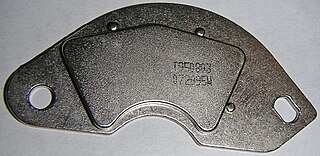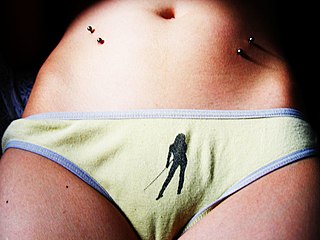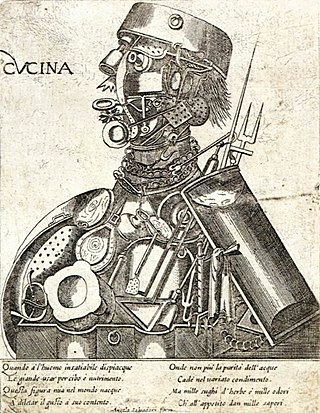
Ferromagnetism is a property of certain materials that results in a significant, observable magnetic permeability, and in many cases, a significant magnetic coercivity, allowing the material to form a permanent magnet. Ferromagnetic materials are noticeably attracted to a magnet, which is a consequence of their substantial magnetic permeability.

Magnetism is the class of physical attributes that occur through a magnetic field, which allows objects to attract or repel each other. Because both electric currents and magnetic moments of elementary particles give rise to a magnetic field, magnetism is one of two aspects of electromagnetism.

A magnetic field is a physical field that describes the magnetic influence on moving electric charges, electric currents, and magnetic materials. A moving charge in a magnetic field experiences a force perpendicular to its own velocity and to the magnetic field. A permanent magnet's magnetic field pulls on ferromagnetic materials such as iron, and attracts or repels other magnets. In addition, a nonuniform magnetic field exerts minuscule forces on "nonmagnetic" materials by three other magnetic effects: paramagnetism, diamagnetism, and antiferromagnetism, although these forces are usually so small they can only be detected by laboratory equipment. Magnetic fields surround magnetized materials, electric currents, and electric fields varying in time. Since both strength and direction of a magnetic field may vary with location, it is described mathematically by a function assigning a vector to each point of space, called a vector field.

A magnet is a material or object that produces a magnetic field. This magnetic field is invisible but is responsible for the most notable property of a magnet: a force that pulls on other ferromagnetic materials, such as iron, steel, nickel, cobalt, etc. and attracts or repels other magnets.
Magnetic therapy is a pseudoscientific alternative medicine practice involving the weak static magnetic field produced by a permanent magnet which is placed on the body. It is similar to the alternative medicine practice of electromagnetic therapy, which uses a magnetic field generated by an electrically powered device. Magnet therapy products may include wristbands, jewelry, blankets, and wraps that have magnets incorporated into them.

A neodymium magnet (also known as NdFeB, NIB or Neo magnet) is a permanent magnet made from an alloy of neodymium, iron, and boron to form the Nd2Fe14B tetragonal crystalline structure. They are the most widely used type of rare-earth magnet.

A synchronous electric motor is an AC electric motor in which, at steady state, the rotation of the shaft is synchronized with the frequency of the supply current; the rotation period is exactly equal to an integer number of AC cycles. Synchronous motors use electromagnets as the stator of the motor which create a magnetic field that rotates in time with the oscillations of the current. The rotor with permanent magnets or electromagnets turns in step with the stator field at the same rate and as a result, provides the second synchronized rotating magnet field. Doubly fed synchronous motors use independently-excited multiphase AC electromagnets for both rotor and stator.

A subdermal implant is a body modification placed under the skin, allowing the body to heal over the implant and creating a raised design. Such implants fall under the broad category of body modification. Many subdermal implants are made out of silicone, either carved or mold injected. Many people who have subdermal implants use them in conjunction with other types of body modification to create a desired, dramatic effect. This process is also known as a 3-D implant, or pocketing.
A samarium–cobalt (SmCo) magnet, a type of rare-earth magnet, is a strong permanent magnet made of two basic elements: samarium and cobalt.

A rare-earth magnet is a strong permanent magnet made from alloys of rare-earth elements. Developed in the 1970s and 1980s, rare-earth magnets are the strongest type of permanent magnets made, producing significantly stronger magnetic fields than other types such as ferrite or alnico magnets. The magnetic field typically produced by rare-earth magnets can exceed 1.2 teslas, whereas ferrite or ceramic magnets typically exhibit fields of 0.5 to 1 tesla.

A hip piercing is a piercing in the pelvic area through the skin near the hip bone. Hip piercings are often done in couplets with one on each hip, but it is not unusual to see only one. Hips piercing are a type of surface piercing. Microdermals or skin divers can be implanted in the hip area to give a similar appearance.
Body hacking is the application of the hacker ethic in pursuit of enhancement or change to the body's functions through technological means, such as do-it-yourself cybernetic devices or by introducing biochemicals.

In body modification, an implant is a device that is placed under the human skin for decorative purposes. Such implants may be subdermal or transdermal. In the context of body modification, some may consider injections of silicone and other substances a type of implant as well.

Mark N. Gasson is a British scientist and visiting research fellow at the Cybernetics Research Group, University of Reading, UK. He pioneered developments in direct neural interfaces between computer systems and the human nervous system, has developed brain–computer interfaces and is active in the research fields of human microchip implants, medical devices and digital identity. He is known for his experiments transmitting a computer virus into a human implant, and is credited with being the first human infected with a computer virus.
A dopant is a small amount of a substance added to a material to alter its physical properties, such as electrical or optical properties. The amount of dopant is typically very low compared to the material being doped.
Steve Haworth is a body modification artist based in Phoenix, Arizona. He is responsible for the invention and popularization of subdermal and transdermal implants, such as the "Metal Mohawk". He designed specialized medical instruments called dermal elevators for this process. He has also done pioneering work with surface bars, ear shaping, tongue splitting, magnetic implants, and artistic branding. He has worked on individuals noted for their extensive modifications such as The Enigma, Katzen, Stalking Cat, The Lizardman, and biohacker Tim Cannon. He is listed in the Guinness World Records as "Most Advanced Body Modification Artist", 1999 to present.
A human microchip implant is any electronic device implanted subcutaneously (subdermally) usually via an injection. Examples include an identifying integrated circuit RFID device encased in silicate glass which is implanted in the body of a human being. This type of subdermal implant usually contains a unique ID number that can be linked to information contained in an external database, such as identity document, criminal record, medical history, medications, address book, and other potential uses.
Tim Cannon is an American software developer, entrepreneur, and biohacker based in Pittsburgh, Pennsylvania. He is best known as Chief Information Officer of Grindhouse Wetware, a biotechnology startup company that creates technology to augment human capabilities. Grindhouse was co-founded by Cannon and Shawn Sarver in 2012. Cannon himself has had a variety of body modification implants, and has been referred to in the media as a cyborg.

Grindhouse Wetware is an open source biotechnology startup company based in Pittsburgh, Pennsylvania. Grindhouse applies the biohacker ethic to create technology that augments human capabilities. The company is most well known for their Circadia device, a wireless biometric sensor that was implanted into co-founder Tim Cannon on the 22 October 2013. Grindhouse has been featured in television shows such as Taboo on National Geographic Channel, Joe Rogan Questions Everything on Syfy, The Big Picture with Kal Penn, as well as podcasts including Future Grind and Roderick Russell's Remarkably Human.

Cyborg art, also known as cyborgism, is an art movement that began in the mid-2000s in Britain. It is based on the creation and addition of new senses to the body via cybernetic implants and the creation of art works through new senses. Cyborg artworks are created by cyborg artists; artists whose senses have been voluntarily enhanced through cybernetic implants. Among the early artists shaping the cyborg art movement are Neil Harbisson, whose antenna implant allows him to perceive ultraviolet and infrared colours, and Moon Ribas whose implants in her feet allow her to feel earthquakes and moonquakes. Other cyborg artists include:















